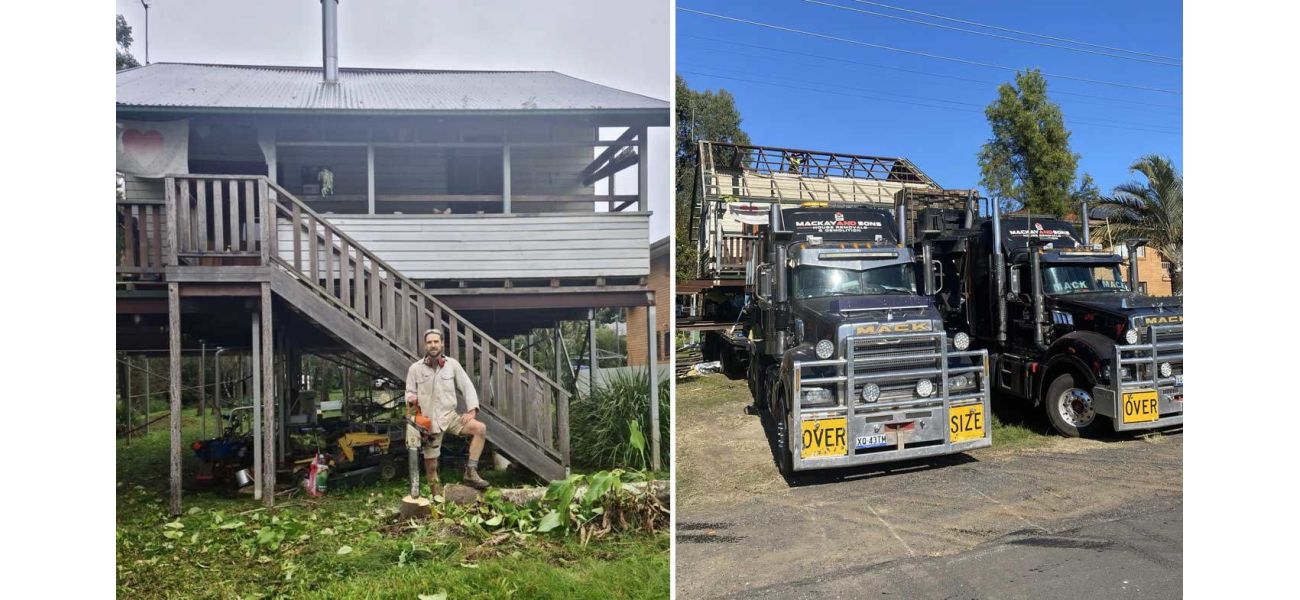Hamish had a strong emotional attachment to his Lismore house, but has now relocated it to Nimbin.
This 110-year-old cottage was cut in half and relocated 30km for $100,000.
September 4th 2024.

As the clock struck midnight, the quiet streets of Terania in Lismore, New South Wales were awakened by the rumbling of trucks. The residents of the Northern Rivers region were not used to such a commotion at this hour, but for Hamish Webster, it was a bittersweet moment. His 110-year-old, two-bedroom worker's cottage was being loaded onto the trucks, ready to be transported to its new home.
The historic house had been chopped in half so that it could comply with the local road load width restrictions. Webster watched with a mixture of nerves and excitement as the workers carefully maneuvered the two pieces onto the trucks. This was the same house that he had poured his blood, sweat, and tears into, rebuilding it after the devastating floods that had swept through the region. He couldn't help but feel a sense of attachment to the house that had become his labor of love.
The relocation of the timber cottage went smoothly, much to Webster's relief. Within 45 minutes, the trucks had reached their destination, a housing development site in Nimbin, 30 kilometres away. It had been two and a half years since the floods of February 2022, and Webster was one of the lucky few who managed to save their homes by relocating them outside of the floodplain.
Thanks to the Resilient Homes program, a government initiative worth $700 million, flood victims like Webster were given the option to sell their land back to the government and take their homes with them to a new location. Webster, who had spent his teenage years in Lismore, had purchased the rundown cottage in December 2020 for $250,000. He saw it as a project that he could sink his teeth into and transform into a beautiful home.
By August 2021, Webster had already spent a considerable amount of money raising the house above the one-in-100-year flood level. However, six months later, the floods struck again, and the water level reached a staggering 1.7 metres above the record flood level. Webster's house was not insured, and he was left to deal with the aftermath on his own.
"It was a chaotic and confusing time for me. I didn't have insurance, so I had to focus on fixing my house," Webster recalled. With 10 months of back-breaking work, he was finally able to move back into his home last year. "It was a proud moment for me, seeing my hard work pay off and turning the house into a beautiful home," he said, beaming with pride. He had become so attached to the house that the thought of abandoning it and leaving its fate uncertain was unbearable. So, when the idea of relocating it was presented to him, he didn't hesitate.
However, the road to getting his house to Nimbin was not an easy one, as Webster soon found out. Initially, the rules of the buyback scheme didn't allow homeowners to live in their property while they were in the process of purchasing new land and arranging for the relocation. Webster fought hard to have this rule changed, and eventually, he was successful.
"It was a stressful time for me because, on the day I received the buyback money, my land settlement and license to occupy post-settlement all came through. It was a race against time," Webster recalled. He received $380,000 for the buyback of his land, while the cost of relocating his home was around $100,000, which varied depending on the size and distance of the house.
For Webster, rescuing a part of Lismore's history was well worth the struggle. "I have a background in furniture making, so timber holds a special place in my heart. All the timber used in these old homes is from untouched, virgin forests, and that's something truly special," he said with a hint of pride.
In July, the Kilburn family also relocated their 100-year-old Lismore home to Modanville, 14.5 kilometres away. Like Webster's home, the Kilburns' house was also transported by truck at midnight. "We were fortunate that our house was narrow enough to be moved in one piece without being cut," said Jo Kilburn, a mother of two.
The journey was nerve-wracking and slow, taking four hours under police escort. "To make things worse, it was bin night, and they had to stop along the way to move the bins," Kilburn added with a laugh. The Kilburns had lived in their historic timber home for 20 years before it was inundated by the floods of 2022. "It holds a special place in our hearts, as we got married the year after we bought it, and our two sons were brought home here," Kilburn shared.
After receiving an insurance payout, the Kilburns spent seven months renovating their home before finding out about the buyback option. Despite the cost of relocating their home, which was around $140,000, it was still cheaper than building a new house. Plus, it allowed them to keep their home, which was filled with precious memories.
"It's a huge relief knowing that we won't have to go through the floods again," Kilburn said, relieved to be located away from the floodplain. However, she also admitted that it felt strange to be living in the same house with a different view. "In our old location, we had a neighbour on one side and a service station on the other. Now, we have a beautiful view of the valley outside our windows. It's quite bizarre," she mused.
Around 5000 homes were flooded in the 2022 Lismore floods, and as of March this year, 700 people across the Northern Rivers had received a buyback offer, according to The Sydney Morning Herald. In 2026, 400 blocks of land in Lismore will be initially opened to flood victims who have received a land buyback. Harper Dalton, a local house relocation advocate, runs the Facebook group, Relocate Lismore Homes. "We don't want to see these beautiful, historical homes demolished. Instead, we should be preserving them by relocating them, rather than replacing them with new builds made from plantation timber," he said.
While Dalton is hopeful that the process of relocating homes will become smoother, he also acknowledges that it can be a difficult and time-consuming process. "It's not something that can be done overnight. Even with the help of relocation companies, it can take up to six months to relocate a house," he explained. "But it's a positive step towards preserving these beautiful old homes," he added with a smile.
The historic house had been chopped in half so that it could comply with the local road load width restrictions. Webster watched with a mixture of nerves and excitement as the workers carefully maneuvered the two pieces onto the trucks. This was the same house that he had poured his blood, sweat, and tears into, rebuilding it after the devastating floods that had swept through the region. He couldn't help but feel a sense of attachment to the house that had become his labor of love.
The relocation of the timber cottage went smoothly, much to Webster's relief. Within 45 minutes, the trucks had reached their destination, a housing development site in Nimbin, 30 kilometres away. It had been two and a half years since the floods of February 2022, and Webster was one of the lucky few who managed to save their homes by relocating them outside of the floodplain.
Thanks to the Resilient Homes program, a government initiative worth $700 million, flood victims like Webster were given the option to sell their land back to the government and take their homes with them to a new location. Webster, who had spent his teenage years in Lismore, had purchased the rundown cottage in December 2020 for $250,000. He saw it as a project that he could sink his teeth into and transform into a beautiful home.
By August 2021, Webster had already spent a considerable amount of money raising the house above the one-in-100-year flood level. However, six months later, the floods struck again, and the water level reached a staggering 1.7 metres above the record flood level. Webster's house was not insured, and he was left to deal with the aftermath on his own.
"It was a chaotic and confusing time for me. I didn't have insurance, so I had to focus on fixing my house," Webster recalled. With 10 months of back-breaking work, he was finally able to move back into his home last year. "It was a proud moment for me, seeing my hard work pay off and turning the house into a beautiful home," he said, beaming with pride. He had become so attached to the house that the thought of abandoning it and leaving its fate uncertain was unbearable. So, when the idea of relocating it was presented to him, he didn't hesitate.
However, the road to getting his house to Nimbin was not an easy one, as Webster soon found out. Initially, the rules of the buyback scheme didn't allow homeowners to live in their property while they were in the process of purchasing new land and arranging for the relocation. Webster fought hard to have this rule changed, and eventually, he was successful.
"It was a stressful time for me because, on the day I received the buyback money, my land settlement and license to occupy post-settlement all came through. It was a race against time," Webster recalled. He received $380,000 for the buyback of his land, while the cost of relocating his home was around $100,000, which varied depending on the size and distance of the house.
For Webster, rescuing a part of Lismore's history was well worth the struggle. "I have a background in furniture making, so timber holds a special place in my heart. All the timber used in these old homes is from untouched, virgin forests, and that's something truly special," he said with a hint of pride.
In July, the Kilburn family also relocated their 100-year-old Lismore home to Modanville, 14.5 kilometres away. Like Webster's home, the Kilburns' house was also transported by truck at midnight. "We were fortunate that our house was narrow enough to be moved in one piece without being cut," said Jo Kilburn, a mother of two.
The journey was nerve-wracking and slow, taking four hours under police escort. "To make things worse, it was bin night, and they had to stop along the way to move the bins," Kilburn added with a laugh. The Kilburns had lived in their historic timber home for 20 years before it was inundated by the floods of 2022. "It holds a special place in our hearts, as we got married the year after we bought it, and our two sons were brought home here," Kilburn shared.
After receiving an insurance payout, the Kilburns spent seven months renovating their home before finding out about the buyback option. Despite the cost of relocating their home, which was around $140,000, it was still cheaper than building a new house. Plus, it allowed them to keep their home, which was filled with precious memories.
"It's a huge relief knowing that we won't have to go through the floods again," Kilburn said, relieved to be located away from the floodplain. However, she also admitted that it felt strange to be living in the same house with a different view. "In our old location, we had a neighbour on one side and a service station on the other. Now, we have a beautiful view of the valley outside our windows. It's quite bizarre," she mused.
Around 5000 homes were flooded in the 2022 Lismore floods, and as of March this year, 700 people across the Northern Rivers had received a buyback offer, according to The Sydney Morning Herald. In 2026, 400 blocks of land in Lismore will be initially opened to flood victims who have received a land buyback. Harper Dalton, a local house relocation advocate, runs the Facebook group, Relocate Lismore Homes. "We don't want to see these beautiful, historical homes demolished. Instead, we should be preserving them by relocating them, rather than replacing them with new builds made from plantation timber," he said.
While Dalton is hopeful that the process of relocating homes will become smoother, he also acknowledges that it can be a difficult and time-consuming process. "It's not something that can be done overnight. Even with the help of relocation companies, it can take up to six months to relocate a house," he explained. "But it's a positive step towards preserving these beautiful old homes," he added with a smile.
[This article has been trending online recently and has been generated with AI. Your feed is customized.]
[Generative AI is experimental.]
0
0
Submit Comment





